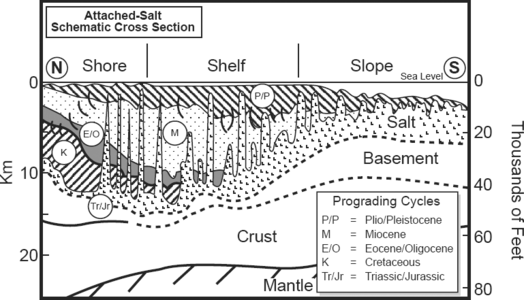Making regional structural cross sections
| Exploring for Oil and Gas Traps | |

| |
| Series | Treatise in Petroleum Geology |
|---|---|
| Part | Critical elements of the petroleum system |
| Chapter | Sedimentary basin analysis |
| Author | John M. Armentrout |
| Link | Web page |
| Store | AAPG Store |
Cross section utility
Regional structural cross sections show interpretations of the present-day geology of a basin. They illustrate the relationship between structure and stratigraphy. Modeling the tectonic history and tectonostratigraphic phases begins with regional structural cross sections and works backward, disclosing important events.
Discussion of GOM basin
Much of the petroleum discovered within the northern GOM basin is in Neogene anticlinal and stratigraphic traps developed as a consequence of interaction between Jurassic salt and Cenozoic siliciclastic progradation. The basic model consists of sediment prograding into the basin and differentially loading the plastic salt, causing diapirs and growth faults to develop.[1][2] Two different interpretations of the present-day geology are presented below in two different structural cross sections. Migration of hydrocarbons from Mesozoic and early Tertiary organic-rich rocks are significantly affected by the selection of either of these two interpretations of salt deformation.
Traditional structure cross section
Traditional regional cross sections, such as in the figure below, have shown highly deformed salt rooted within the in-place Middle Jurassic mother salt. Such cross sections have been used to suggest that successive progradation of siliciclastics loaded and displaced the salt as each sedimentary cycle's depocenter stepped progressively basinward. Differential loading of the salt formed deeply rooted diapirs and shallow growth faults as a result of sediment downbuilding and consequent displacement of salt. Mature source rocks occurring between the deeply rooted diapirs could yield hydrocarbons able to migrate within each salt-walled compartment of each depocenter.
Recent structure cross section
More recent models of salt deformation recognize both the in-place Middle Jurassic mother salt and displaced sheets of Middle Jurassic salt that have become detached from the mother salt as shown in the figure below. The detached salt is emplaced progressively over younger sediments because of the passive response to differential loading by sediment and gravitational forces. Basinward gravitational slope failure forms major growth fault systems on the upper slope and toe-thrust structures downslope.[3] Each “pulse” of salt displacement evolves through a new generation of deformation.[4][5][6][7] Maturing source rocks of Mesozoic and early Tertiary age can yield hydrocarbons that may migrate vertically along growth faults and salt walls, through holes in salt canopies, laterally below salt, or within sandstones between salt sheets.
Basin evolution
Figure 1 Modified after Antoine et al.[8] Courtesy Springer-Verlag.
Figure 2 From Hall et al.[9] Courtesy Gulf Coast SEPM.
The contrast between the cross sections of Figures 1 and 2 illustrate changing concepts of basin evolution. When constructing a basin's history, we must understand the concepts underlying each previous study so we can fully appreciate the subtle changes in geologic models and take into account their consequences as the basin model evolves.
See also
- Making regional tectonic maps
- Determining plate tectonic setting and history
- Determining tectonostratigraphic history
- Using a tectonic history model for petroleum system analysis
- Structural maps and cross sections
- Regional maps and cross sections
References
- ↑ Trippet, A. R., 1981, Characteristics of diapirs on the outer continental shelf–upper continental slope boundary, northwest Gulf of Mexico: Gulf Coast Assoc. of Geological Societies Transactions, vol. 31, p. 391–397.
- ↑ Ingram, R. J., 1991, Salt tectonics, in D. Goldthwaite, ed., An Introduction to Central Gulf Coast Geology: New Orleans Geological Society, p. 31–60.
- ↑ Bruce, C. H., 1973, Pressured shale and related sediment deformation: mechanism for development of regional contemporaneous faults: AAPG Bulletin, vol. 57, p. 878–886., 10., 1306/819A4352-16C5-11D7-8645000102C1865D
- ↑ Fiduk, J. C., E. W. Behrens, and R. T. Buffler, 1989, Distribution and movement of salt on the Texas–Louisiana continental slope, Garden Banks and eastern East Breaks areas, Gulf of Mexico: Proceedings, Gulf Coast Section SEPM 10th Annual Research conference, p. 39–47.
- ↑ West, D. B., 1989, Model for salt deformation on deep margin of central Gulf of Mexico basin: AAPG Bulletin, vol. 73, p. 1472–1482.
- ↑ Koyi, H., 1993, Modeling of segmentation and emplacement of salt sheets in anisotropic overburden: Selected Papers, Gulf Coast Section SEPM 13th Annual Research conference, p. 135–142.
- ↑ McGuinness, D. B., and J. R. Hossack, 1993, The development of allochthonous salt sheets as controlled by the rates of extension, sedimentation, and salt supply: Proceedings, Gulf Coast Section SEPM 14th Annual Research conference, p. 127–139.
- ↑ Antoine, J. W., R. G. Ray, Jr., T. G. Pyle, and W. R. Bryant, 1974, Continental margins of the Gulf of Mexico, in C. A. Burk, and C. L. Drake, eds., The Geology of Continental Margins: New York, Springer-Verlag, p. 683–693.
- ↑ Hall, D. J., B. E. Bowen, R. N. Rosen, S. Wu, and A. W. Bally, 1993, Mesozoic and early Cenozoic development of the Texas margin: A new integrated hydrocarbon system study, northern Gulf of Mexico basin: Abstracts, 1st Latin American Geophysical Conference, p. 1-4.

